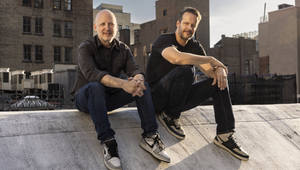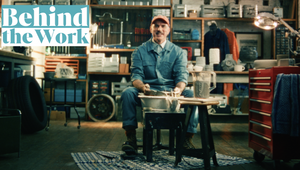
5 Minutes with… Imogen Fox

Imogen Fox began her career at the Guardian in 2004, joining the newsroom as assistant fashion editor and progressing to head of fashion. Working in the Guardian’s commercial department since 2016, she has held a number of leadership roles including executive editor of Guardian Labs and director of advertising. Imogen took on the role of chief advertising officer in 2023 and was promoted to global chief advertising officer in February this year.
In her expanded remit, Imogen is taking on commercial responsibility for the Guardian’s advertising strategy internationally as the paper continues on its mission to remain independently funded while taking a stance against advertising from fossil fuel and gambling companies – the only major news organisation to have done so.
The Guardian's readership is growing rapidly, according to Imogen, reaching over 21 million visitors a month in the UK and outperforming the Wall Street Journal, Bloomberg, and the Daily Mail in the US. Imogen says that the advertising community hasn’t yet caught up with the opportunity that advertising with, and in, the newsbrand presents – a challenge that she will be undertaking with the continued implementation of the Guardian's commercial strategy, focused on its “unique scale, influence, and integrity.”
LBB’s Zhenya Tsenzharyk spoke to Imogen to learn more about the Guardian’s reader-first approach to branded advertising through Guardian Labs; using AI to enhance reader experience and never for innovation’s sake; and why journalistic integrity must never suffer in the face of commercial demands.
LBB> What are the current successes and challenges for the Guardian’s advertising business internationally? How are you predicting that these successes and challenges will evolve over the next 12 months?
Imogen> The Guardian’s independently funded, progressive and trusted journalism is needed across the world by readers, now more than ever. Our audience continues to grow rapidly, reflected in the growth of our international editions. In the UK, the Guardian is the most-read quality newsbrand, reaching over 21 million unique visitors a month. In the US, we are now more read than the Wall Street Journal, Bloomberg and the Daily Mail, and our Australian edition is in the top five news outlets in the country.
Although we’re growing, I’m not sure the message has fully translated to the advertising community worldwide. That’s a huge opportunity. It’s proven that advertising works best when it’s seen by millions of people in a premium environment on a platform they trust. Over the next 12 months, the challenge will be to articulate to advertisers why this matters, remind them who the Guardian is, what we stand for and where we’re heading in the future. Last year we launched a new strategy focused on the unique scale, influence and integrity that we offer. We are seeing real success – direct to client and agency deals are up and our advertising department is cutting through in a tough market.
LBB> What key differences do you see in advertising trends across the UK, US, and Australian markets, and how will you tailor your global strategy accordingly?
LBB> We don’t really see ourselves as responding to advertising trends, our strategy is the same across all regions. For us it’s about the type of readership we have, why we’re different and how we can use our uniqueness to benefit advertisers.
Our reputation as a responsible, impactful media organisation matters to audiences and sets us apart in the global market. Of course, we are still a relatively newer player in the US and Australia, so we are working hard to tell the industry who we are and why they’d want to work with us. There will always be nuances which is why we have dedicated sales teams in all three. But we believe that scale, influence and integrity is a global story we can tell with local accents.
LBB> As someone who transitioned from editorial roles to commercial leadership, how has your journalism background influenced your approach to advertising strategy?
Imogen> As a former journalist I believe in calling things what they are. At the Guardian, we create great work, we make great advertising, and get it in front of an audience that enjoys engaging with it. My editorial background provides a strong foundation for understanding and upholding the Guardian’s values and why our journalism is important, engaging, and often brilliantly fun. Unlike competitors, Guardian Advertising takes a reader-first approach, ensuring that commercial content complements rather than disrupts the user experience.
Through extensive testing, we carefully balance editorial and advertising, maintaining an engaging environment for our audience, while achieving commercial impact for our clients.
As an ex-fashion journalist I am always drawn to our lifestyle journalism. Our customers know us for our news and as a team we love to highlight the Guardian’s diverse offering, demonstrating to advertisers how we can elevate brands through thoughtful, high-quality content that resonates with audiences in meaningful ways.
LBB> What role does branded content play in the Guardian’s advertising strategy, and how do you ensure it aligns with audience expectations and editorial values?
Imogen> Our audience expects great journalism when they come to the Guardian. Our branded content team has been set up to deliver that in a commercial context. Clear and transparent labelling on all our Guardian Labs work means people understand that it’s a long form ad; and our dwell times and viewability rates prove it’s work people will actively choose.
We revamped our offering recently, introducing formats like the digital showroom to show off great brand assets and feature presentations that deliver magazine quality design work taking audiences on an immersive journey. We’ve had successful social-first campaigns with real cut through for brands like Clarins and Encona, published original poetry for Woodland Trust, and brought AI to life for Samsung with star columnist Hannah Fry. Audible also worked with us last year to create a launch moment for their new audiobook version of George Orwell’s ‘1984’. We ran a ‘doublespeak decoder’ idea across print, digital and audio that allowed them to really deepen their wider ‘Glitching into Culture’ strategy.
As a result of the innovation and hard work across the sales team, our Labs partnership work revenue is growing by 8% year-on-year and our pitch conversion rate has never been higher.
LBB> How do you see AI and emerging technologies shaping the future of advertising at the Guardian and the industry at large?
Imogen> The tech around AI is moving so fast and has required us to think deeply about how we use the tools available. We are open to using this technology in a responsible way around advertising, with emphasis on genuinely understanding and using it effectively. As a journalist-led organisation, we hold ourselves to very high standards and our work in this area is careful and considered.
There are some interesting possibilities around more descriptive and useful metadata which could improve the relationship between adverts, audiences, and journalism. But in some ways the most interesting aspect of GenAI is how it could affect existing platforms (such as Google search), emerging platforms (like ChatGPT), and user behaviour around advertising. This is a significant moment in digital that we are watching carefully for both the opportunities and risks.
We never want innovation for innovation’s sake: we use new tools like AI when they can really add to our audience’s experience. As an example, when we were planning our brilliant new cookery app, Feast, we knew the Guardian had over 30k recipes in the archives. That sounds like the perfect ingredient for a cooking app – but in reality it was really complicated – for example, Nigel Slater’s recipes are beautiful essays and Ottolenghi has his own unique style. So we used AI to structure them by ingredients, cooking times, units, and then turned the best of them into recipes on the app for all our foodies.
LBB> How do you plan to balance the Guardian’s journalistic integrity with the commercial demands of global advertising partnerships?
Imogen> No matter where in the world the Guardian is read, the mission and quality of our journalism remains the same, as does the opportunity to advertise in front of a huge global audience.
Many of our commercial partners choose to advertise with us because of our purpose and values, knowing that the Guardian offers a brand-safe environment built on trust and integrity. Increasingly, we’re seeing advertisers prioritise these factors in their spending decisions.
At the Guardian, responsible advertising is a key priority and our strong progressive values continue to shape our approach. We remain the only major news organisation to have banned advertising from fossil fuel and gambling companies. While this decision posed short-term challenges, it was the right thing to do and we’re proud to see the overwhelmingly positive response from both our readers and advertisers as a result.
LBB> How can brands leverage the Guardian’s reputation for trust and integrity to create more meaningful and impactful advertising campaigns?
Imogen> The Guardian is the daily ‘go to’ source of information for readers, especially when huge events are happening. Whether that’s Glastonbury, the Euros, or a show like ‘Adolescence’, we’re really good at putting brands at the heart of culture.
Traditionally, brands have been cautious about buying advertising around hard news online. However, last year BT turned this idea on its head and took the opportunity to sponsor the Guardian’s 2024 election coverage, at a time when our readers were highly engaged. Our multi-platform approach meant digital takeovers, visibility on our live blogs, spot ads across our daily news podcast ‘Today in Focus’, high impact print ads on the days following the election, 100% share of voice in daily newsletters like ‘First Edition’, and audience targeting using the Guardian’s best-in-class first-party data.
It’s good to know that BT were bold enough to trust our editorial team, put themselves at the heart of what the nation was reading for those six weeks, and reap the rewards for their business and brand.
LBB> What advice would you give to advertisers looking to build long-term trust with audiences in an era of misinformation and declining public confidence in the media?
Imogen> Misinformation has always existed but what’s different now is the ease with which it’s generated and the speed at which it spreads. It’s worrying to think that some platforms have proactively abandoned the use of independent fact-checkers, which really highlights the importance of fact-based journalism. What the Guardian stands for – quality and trust – becomes rarer and more valuable to readers and advertisers.
The positive side is that newsbrands and quality media seem to be having a moment. There’s a growing awareness of how advertising shapes the world through media and the types of media being funded. EssenceMediacom’s recent signalling strength study revealed that media channel choices affect the way consumers perceive product and service quality and, ultimately, how much they trust a brand.
My advice for advertisers would be to revisit the first principles of good advertising: showing up in places professionally produced by real people, with high-quality environments and beautiful design. For me, that’s the Guardian.















